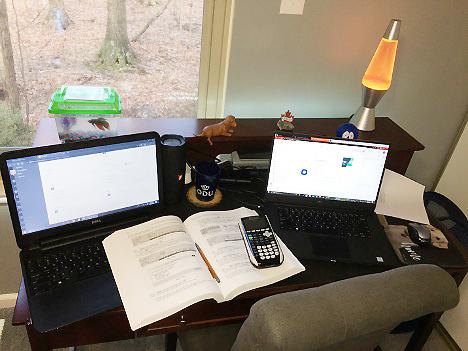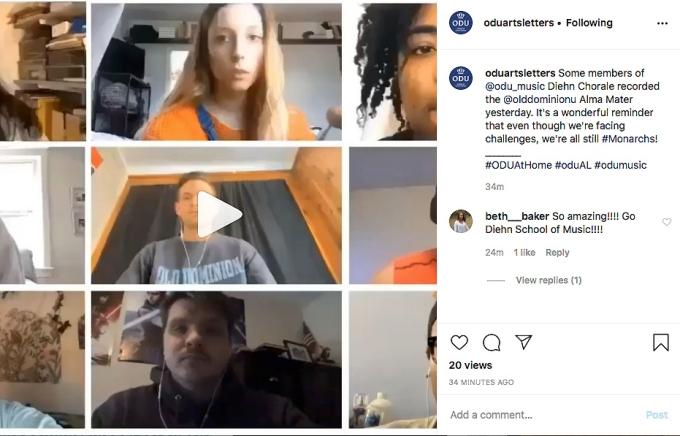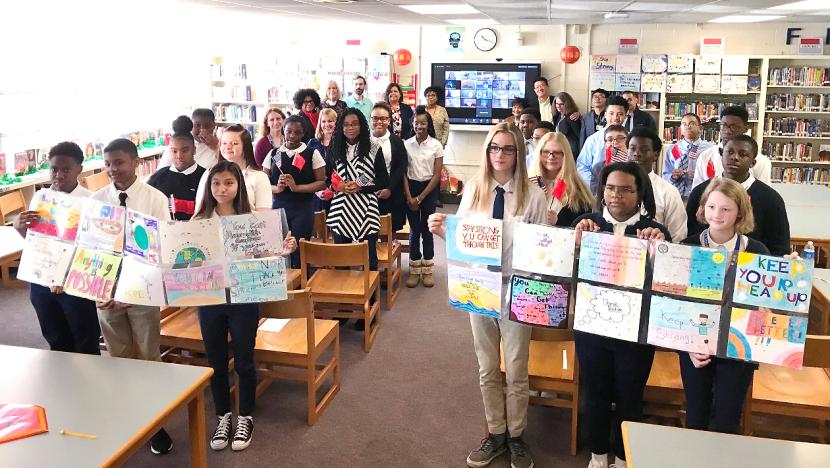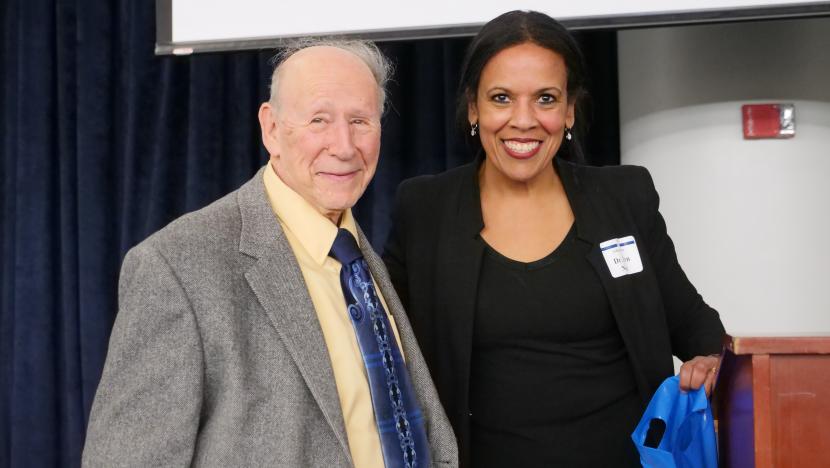View gallery
Listen to the ODU Alma Mater performed remotely by the ODU Diehn Chorale
By Sherry DiBari
During the first week of working remotely, Old Dominion University faculty, staff and students quickly became entrenched in Zoom, Blackboard, Google Docs, shaky internet connections and creative workarounds.
Jon Lester, senior lecturer in engineering technology, couldn't teach his class from home because of poor internet connections and ended up driving to a closed public library to use Wi-Fi from the parking lot.
Katie Morris, engineering technology academic program support, has a new tie-wearing feline office assistant named Socks. Morris said Socks is "super happy" that she is home all the time now. "He likes to sit beside me on the couch when I work in my living room or nap on my bed when I'm working at my desk to provide moral support."
Isao Ishibashi, who spent over 30 years teaching and conducting soil labs in person, said the "transition challenged him to further elevate his technical skills." He credits colleagues who helped to "share their knowledge and best practices to transition his classes" to remote learning.
Engineering student Jake Koneczny said the first week of online classes wasn't as bad as he thought it would be.
"The workload was a bit heavier because all the teachers were trying to get us caught up from the extra week of spring break," he said. "It is nice being able to wake up five minutes before class, opening your computer and still starting class on time. The hardest thing about the online classes is trying to watch the teachers understand how to use this Zoom program."
Social media has helped to keep the Old Dominion University community connected.
Communications major Allen Sawyer tweeted a photograph of his dog, Sawyer, as he worked at home. "He seems to love having me home" Sawyer said. "I know I definitely don't mind being around him a lot!"
Sawyer's biggest challenges have been staying focused on schoolwork with the family at home and navigating the different software used for classes.
"One the few positives I have gotten from all of this is I've been able to communicate a lot more with people from my church, from ODU and family (even though it's virtual)," Sawyer said.
Students and faculty have responded to a social media request to post images with the hashtag #ODUAtHome. Photographs have included virtual class screenshots, laptops set up on kitchen tables and people working from home with pets and children.
Members of the Diehn Chorale sang the ODU Alma Mater in virtual harmony and posted an #ODUAtHome videoto Instagram.
The ODU geography program Facebook page posted a #ODUAtHome image of a virtual faculty meeting showing everyone at their home computers. This was a common across social media channels.
Julie Cavallario, assistant professor in rehabilitation sciences, tweeted an #ODUAtHome photograph of her 7-year-old also working (first grade) from home.
Cavallario felt that her transition was fairly easy because her program incorporates both online and in-person courses.
However, she suggested working remotely is different than teaching online.
"When we teach online, we still are at work, interacting with colleagues, and with access to a variety of physical materials that we integrate into our teaching and research," Cavallario said. "This new work environment is different for all of us, even if we have taught online courses in the past."
Cavallario suggested that the challenges and positives of working from home "go hand in hand."
"For me personally, it is great to get more family time, however, teaching synchronously online while my kids are home and have synchronous online education happening throughout the day, and a spouse that has been converted to a virtual employment setting too, has been challenging," Cavallario said.
She is appreciative of the universal sense of community and how faculty and students at ODU have come together to support each other.
"So many offers of assistance, group support, workshop availability or just general collaboration have been born out of this challenge, and that is reassuring during a chaotic time," Cavallario said.
Related News Stories
ODU Professor Organizes Videoconference for Children Affected by Coronavirus
Norfolk’s Rosemont Academy students speak with peers in China. (More)
Sonenshine Infectious Diseases Speaker Says, “We Have a Great Opportunity to Take Our Own Health into our Own Hands”
Ground-breaking researcher discusses genomic sequencing and the human microbiome. (More)
Keep Calm and Keep Teaching
ODU’s Center for Learning and Teaching is ready to assist faculty with the transition to online classes. (More)










